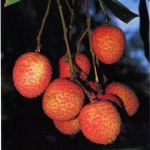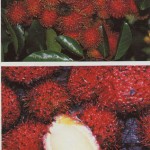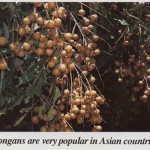Lychee, Rambutan & Longan
 The lychee (Litchi chinensis) and its relatives are some of the finest fruit from South East Asia. Although closely related, the ecological requirements of the fruit differ. The lychee is the most popular Chinese fruit, and is extensively grown in the sub-tropical south east, where it has been cultivated for well over a thousand years. The fruit originated either there, or in the ancient kingdom of Annam which is now central Vietnam.
The lychee (Litchi chinensis) and its relatives are some of the finest fruit from South East Asia. Although closely related, the ecological requirements of the fruit differ. The lychee is the most popular Chinese fruit, and is extensively grown in the sub-tropical south east, where it has been cultivated for well over a thousand years. The fruit originated either there, or in the ancient kingdom of Annam which is now central Vietnam.
The longan’s (Euphoria longan) origin is disputed. It may be native to the west of Burma or alongside the lychee in China. It is in these regions that it is planted on a large scale. Longan is a prolific bearer and thrives in monsoonal regions with pronounced rainy and dry seasons. Longan is by a wide margin Thailand’s greatest fruit export, beating pineapple, durian, and pummelo in money value. A very close relative of the longan, the mata kuching (E. malaiensis), also known as cat’s eyes, is cultivated in many areas of South East Asia.
The rambutan (Nephelium lappaceum) and the pulasan (N. mutabile) are from the south east Asian archipelago. They prefer high humidity and rainfall and little variation from a 28ºC daily mean temperature. The pulasan is a little larger than the rambutan, with fewer fruit per panicle, but appearance and eating quality is very similar.  The rambutan has soft spines, whereas pulasan is covered with little rubbery studs.
The rambutan has soft spines, whereas pulasan is covered with little rubbery studs.
The lychee is a distant relative of the akee. Lychee seed contain parts of hypoglycins like those found in the akee. They, and presumably the seed of near lychee relatives, are toxic and should never be consumed.
All of these fruit vary in quality, depending on cultivar and growing conditions. The quality is reflected by the price range observed at a Thailand market. The cheapest longans, from seedling trees, cab be one twentieth of the price asked for the best recognised cultivars.
Lychees are harvested during early summer, longans during mid and late summer and rambutans, due to its many varieties, are available for much of the year with the main harvest in autumn. Maturity is indicated through a change in colour: in lychee no trace of green should remain when harvested. However, this colour change differs, not only among the three fruit, but almost as much among cultivars. The best practical test is to taste the fruit, which should be quite sweet. Commercially, there is pressure to harvest prematurely to obtain higher prices or to minimise losses to wildlife. Fruit is harvested by cutting off the entire panicle. Later lychees and rambutans are separated from the fruit stalk. Longans are best marketed on the fruitstalk, or they should at least retain a short piece of stem. Plucking the fruit during harvest results in skin tears and fruit left on the panicle keeps better.
Lychee, longan and rambutan are premier dessert fruit and are usually eaten fresh. Lychee and rambutan appeal to most palates. Although the longan has a sweet and rich flavour, some varieties are musky, and the taste must be acquired. But ultimately many people prefer longans.
To open rambutans and pulasans, partially cut through the skin, or just break open using a strong thumb-nail. Longans and lychees may be opened by tearing the skin at the stem end, squeezing the fruit at the lower end, and popping it into the mouth. “Experienced lychee eaters” bite lightly  through the skin of the upper third of the fruit to obtain an opening in the skin and squeeze the fruit out.
through the skin of the upper third of the fruit to obtain an opening in the skin and squeeze the fruit out.
Lychees may be dried within their shells. The sun dried lychee is well known as lychee-nut and this was the only form in which lychees were available prior to about 1950. In taste and texture these are similar to a date. Canned lychees are readily available. The longan does not require the addition of sugar and retains flavour better than lychee or rambutan. Either of the three fruit is an excellent addition to fruit salads, but they are also quite versatile as shown in some of the main course recipes.
All three fruit may be kept at room temperatures for only two or three days. The longan is enveloped in a smooth, beige-brown, leathery skin. Nonetheless the fruit is highly perishable unless special precautions are taken, such as reducing fruit temperature immediately after harvest. They keep better under refrigeration, and when wrapped in plastic. They may also be frozen, but both texture and taste suffer with the length of storage, especially if the freezer temperature is minimal. After thawing, fruit may be used as if they were fresh.
Recipes
| 2 cloves garlic 10ml crushed coriander roots (?) vegetable oil 125g minced pork 50ml coarse ground, roasted peanuts 20ml soy sauce 60ml palm or brown sugar pepper 1 chopped, de-seeded chili 30ml fresh coriander leaves (or parsley) 500ml peeled and de-seeded rambutans |
Fry crushed garlic and coriander roots in oil. When garlic is golden, add all other ingredients except rambutans. Cook and stir until the mixture is browned, and fairly dry, add rambutans. Cook and mix well for about 2 minutes. Serve as an entree, hors-d’oeuvre, or as a main course with rice. Other fruit, for instance, lychees, longans, mandarins or pineapple pieces may be substituted. |
| 2 thinly sliced chicken breasts vegetable oil 20ml soya sauce 150ml pitted, stewed lychees or abiu and their juice 150ml sliced, stewed carambola and juice 5ml minced, green ginger 40ml sherry or port 20ml cornflour & water |
Saut‚ chicken in oil for 2 minutes. Add soya sauce, fruit solids, ginger and sherry and continue to cook for another 2 minutes. Add juices from stewing the fruit and bring to the boil. Mix cornflour with a little water, add to the dish and reboil until sufficiently thickened. Serve with rice and skinned, crumbed chicken legs and chinese vegetables. |
| 1 ham 500ml peeled, de-seeded lychees |
During the last few minutes of browning the ham, cover it with lychees. Use tooth-picks to fasten lychees. The fruit imparts flavour and also serves as a tenderiser. Baked lychees are delicious. |
| lychee syrup 500ml water 1 large, crumbled chicken stock cube 60ml dry sherry 60ml cornflour additional 60ml water 30ml chopped parsley |
Combine lychee syrup (from next recipe), water, stock cube and sherry in a saucepan. Boil for 5 minutes. Add cornflour, blended with extra water, and stir into sauce. Continue stirring over medium heat until sauce boils and thickens. Add parsley, stir through sauce. |
| 425g can lychees 500g pork & veal mince 125ml shredded coconut 200ml stale breadcrumbs grated rind of lime 30ml lime juice 1 lightly beaten egg 5ml fresh chopped mint 40ml chopped fresh parsley |
Drain lychees, reserving syrup for sauce, chop lychees. Combine lychees, mince, coconut, breadcrumbs, lime rind, juice, egg, mint and parsley in large bowl; mix thoroughly. Seasoning is sufficient to stuff a 3kg turkey. |
| 1kg of trevally fillets celery tops, parsley, thyme 40g butter 200ml chopped onions 250g mushrooms 500ml peeled, pitted lychees 60g butter 80ml flour 200ml chicken broth 200ml plain yoghurt 700ml soft breadcrumbs pepper |
Poach fillets for 5 minutes, in a large shallow saucepan or frying pan, containing 10mm depth of water, celery tops, parsley and thyme. Drain, place half of fillets in a greased baking dish, set the remaining fillets aside. Melt 40g of butter in pan containing thyme, parsley, celery, add onion and mushrooms. Saute until golden, add lychees and spread contents over the fillets in the baking dish. Place remaining fillets on top. Melt remaining butter in a saucepan and stir in flour. Brown lightly, then, slowly add broth and yoghurt, stirring continuously. Cook until smooth and thick. Add remaining seasoning to taste. Pour sauce over fish, sprinkle with crumbs. Bake at 200ºC for 20 minutes. Alternatively, cover dish with plastic and microwave for 5 minutes. |
| sponge fingers or other plain cake 500ml peeled, de-seeded and sliced lychees, soaked in brandy overnight 300ml whipped cream |
Line a deep mould or glass dish with sponge fingers, or 2 layers of thinly cut sponge or plain cake to form a shell about 12mm thick. Fold brandied lychees into stiffly whipped cream. Fill mould with mixture and chill until ready. |
| 1 litre plain ice cream 20ml sugar 130g butter 500ml crushed cornflakes 500ml pitted, shelled lychees |
Ice cream should be fairly soft. Leave ice cream in refrigerator for one or two hours, or microwave briefly. Mix sugar, melted butter and crushed cornflakes in a large bowl. Divide into three portions. Use one portion to line inside of a 220mm loaf tin. Mix soft ice cream with shelled, pitted and coarsely chopped lychees. Spread half of the ice cream mixture over crumb mix, followed by the second portion of crumb mix. Top with remaining ice cream, and crumbs. Cover with a piece of baking foil and freeze until firm. |
| 700ml lychees 125g softened cream cheese 60ml finely chopped glace ginger 60ml finely chopped pecans 20ml port or brandy |
Peel and remove seeds from lychees. Mix all other ingredients and fill lychees with cheese mixture. Arrange lychees on lettuce leaves on a platter and serve as an appetiser, with salad or coffee. |
| 1 stale sponge cake 40ml brandy or port 500ml fresh, pitted, shelled lychees 500ml mango puree 600ml custard 200ml whipped cream |
Cut cake in to 12mm cubes and place in serving bowl. Sprinkle port or brandy over the cake. Chop lychees and mix with mango puree and custard at about room temperature. Pour custard mixture over the cake. Refrigerate and decorate with whipped cream before serving. |
| 1 baked tart case 50ml custard powder 30ml cornflour 500ml milk 250ml desiccated coconut 80ml sugar 500ml chopped rambutan or abiu 15g butter 250ml black persimmon 250ml whipped cream |
Mix custard powder and cornflour with 100ml of milk and stir until smooth. Heat remaining milk, coconut, sugar and fruit to boiling, add custard mixture. Simmer for 3 minutes stirring continuously. Remove from heat and add 15g butter. Cool mixture a little and pour into tart shell. Chill, once cooled to room temperature. Before serving cover tart with a mixture of black persimmon pulp and whipped cream. |